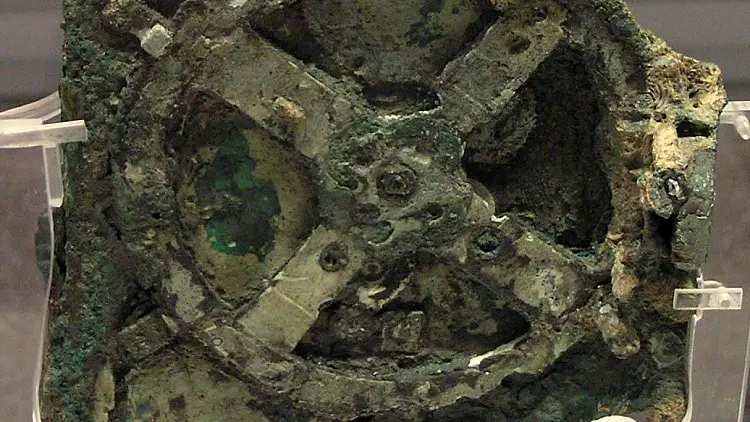12 Advanced Ancient Technologies That Should NOT ExistA look at several advanced ancient technologies that should not have existed until thousands of years later. Where did they come from? Who invented them? Why are they isolated in history?
Advanced ancient technologies are tangible, physical evidence that history, culture and perhaps even Reality itself may not follow the linear procession of time that we are accustomed to. They're physical glitches in The Matrix, as it were.
These advanced ancient technologies are artefacts that have been found out-of-place in archaeological digs, objects that indicate ancients used advanced technology, and artefacts that simply defy any explanation - yet they're sitting there in museums, stubbornly contradicting accepted history. With countless wars and no documentation in the modern language, we lost a lot of knowledge about the previous civilisations so now we are forced to either rewrite history or simply sit head-scratching and admit that "no one really knows."
Let's examine each one in more detail, and see if we can get to the bottom of these eternal mysteries.
The Baghdad Battery from Iraq
Electricity is commonly believed to have been discovered during the 17th century. In the year 1600, English physician William Gilbert used the Latin word "electricus" to describe the force that certain substances exert when rubbed against each other. A few years later another English scientist, Thomas Browne, wrote several books and he first used the word "electricity" to describe his investigations based on Gilbert's work. In 1752, Ben Franklin conducted his experiment with a kite, a key, and a storm. This simply proved that lightning and tiny electric sparks were the same things, thus electricity was born.
Would you believe that electricity was discovered, and used, as early back as 250 BC and AD 224? The Baghdad Battery, or Parthian Battery, discovered in 1938, in what is now modern Khujut Rabu, Iraq, is a ceramic pot, a tube of copper, and a rod of iron. Its origin and purpose remain unclear, and further evidence is needed to explain its purpose. It was hypothesised by some researchers that the object functioned as a galvanic cell, possibly used for electroplating or some kind of electrotherapy, but there is no electro-gilded object known from this period.

The Baghdad batteries could certainly conduct an electric current because many replicas have been made. Modern replicas can produce voltages from 0.8 to nearly two volts. Making an electric current requires two metals with different electro potentials and an ion-carrying solution, known as an electrolyte, to ferry the electrons between them. Connected in series, a set of batteries could theoretically produce a much higher voltage, though no wires have ever been found that would prove this had been the case.
The Lycurgus Cup of Rome
The Lycurgus Cup is a 4th-century Roman glass cage cup. It is remarkable both for the method of fabrication and the exceptional workmanship involved. But that is not why it is on this list. The Lycurgus Cup is made of dichroic glass, which shows a different colour depending on whether or not light is passing through it; red when lit from behind and green when lit from in front.

The dichroic effect is achieved by making the glass with tiny proportions of nanoparticles of gold and silver dispersed in colloidal form throughout the glass material. It is among the most technically sophisticated glass objects produced before the modern era. Research into how glass makes this dichroic effect has led researchers to believe that the Roman artisans were nanotechnology pioneers. They'd impregnated the glass with particles of silver and gold, ground down until they were as small as 50 nanometres in diameter, less than one-thousandth the size of a grain of table salt. The exact mixture of the precious metals suggests the Romans knew what they were doing.
The Tecaxic-Calixtlahuaca Head in Mexico
The mysterious Tecaxic-Calixtlahuaca head was discovered in 1933, and according to researchers, it seems to be a fragment of a larger figure. It was discovered in a pre-Columbian tomb near Tecaxic-Calixtlahuaca in the valley of Toluca by archaeologist Jose Garcia-Payen. According to the first tests, scholars believe that the figure is of Roman origin. This archaeological site was intact, eliminating the possibility of accidental contamination. How did a Roman artefact find its way to Prehispanic Mexico?

When the artefact was discovered, there was no dating method for that type of material, so it wasn't until 1995 when a thermoluminescence test was performed by P. Schaaf and GA Wagner in the "FS Archaeometrie unit" of Heidelberg, Germany placing it between the 9th century BC and the middle of the 13th century AD.
Since the figure is much older than the archaeological site where it was discovered, researchers have speculated that it got there by an ancient route, from Asia to America brought by ancient Hindu or Chinese ships. The only thing that contradicts this theory is the fact that the artefact is too fragile to survive a millennium of travel.
No one can reach a definitive conclusion on the matter. The truth is, the mysterious Tecaxic-Calixtlahuaca head is an enigma, and even though there have been many theories proposed explaining the mysterious artefact and its origin, none of them can be corroborated and the Tecaxic-Calixtlahuaca head remains a mysterious out-of-place artefact.
Is it possible that we know very little about our history and that there have been countless visitors to the Americas before the arrival of the conquistadores?
The Antikythera Mechanism of Greece
Off the coast of the island of Antikythera, divers discovered a wreck which was to yield a priceless collection of Greek statues and other items. The yield from further dives during 1900-01 included an encrusted bronze lump, whose astronomical significance was only recognized some eight months after excavations had terminated when it was found to have split apart. Containing some 30 gear wheels, and now known as the Antikythera Mechanism, this device is an order of magnitude more complicated than any surviving mechanism from the following millennium. There is no surviving precursor.

The Antikythera Mechanism has been dated to the second century BC. After much investigation, researchers have discovered that the mechanism is an ancient computer capable of tracking astronomical movements with remarkable precision. The computer was able to follow the movements of the moon and the sun through the Zodiac, predict eclipses and even recreate the irregular orbit of the moon. They also believe it may also have predicted the positions of the planets. No other civilisation is known to have created anything as complicated for another thousand years.
Roman Concrete
Modern concrete - used in everything from roads to buildings to bridges - can break down in as few as 50 years. But more than a thousand years after the Western Roman Empire crumbled to dust, its concrete structures are still standing. The recipe has been known for a long time, but what is unknown is the exact mixture and method for producing it.
The ancient recipe for mortar, as laid down by Roman engineer Marcus Vitruvius in BC 30 called for a concoction of volcanic ash, lime, and seawater, mixed with volcanic rocks and spread into wooden moulds that were then immersed in more seawater.
If these ingredients were mixed in the manner of modern concrete and placed in a structure, the result certainly would not pass the test of the ages.

So why do structures built only a few years ago look like they've been weathering the elements for centuries, when buildings thousands of years old, like many parts of the Pantheon or Trajan's Markets in Rome, look like they're only a few years old?
Damascus Steel
When the Crusaders reached the Middle East in the 11th century, they discovered swords made of a metal that could slice a hair in half in mid-air, and yet it was strong enough to strike fear into even the bravest and most persistent warrior. What made the swords extraordinary was that the blades remained devastatingly sharp and tough through battle after battle.
Knowledge of the legendary metal spread and it became known to the Europeans as the Damascus steel, named after the capital of Syria. Sometime in the 18th century, the formula for Damascus steel was lost and the original method for producing the Damascus steel remains an ancient secret.
Damascus steel was the forged steel comprising the blades of swords smithed in the Middle East from ingots of wootz steel imported from India and Sri Lanka. These swords are characterized by distinctive patterns of banding and mottling reminiscent of flowing water.

The Arabs introduced the Indian wootz steel to Damascus, where a weapons industry thrived. From the 3rd century to the 17th century, India was shipping steel ingots to the Middle East. By 1750, production of Damascus swords gradually declined because firearms replaced swords and there was less demand for the metal. Eventually, the knowledge and the process were lost to metalsmiths.
Many modern attempts have been made to reproduce the metal, but no one has been entirely successful due to differences in raw materials and manufacturing techniques. "Modern Damascus" is made from several types of steel and iron slices welded together to form a billet, and currently the term "Damascus" (although technically incorrect) is widely accepted to describe modern pattern welded steel blades in the trade. The patterns vary depending on how the smith works the billet.
Stone Spheres of Costa Rica
Found deep in the jungles of Costa Rica in the 1930s were 300 nearly perfectly round stone balls. They varied in size from a few inches in diameter to seven feet across and weighing 16 tons. Scientists aren't sure who made them, how old they are or what purpose they might have had.
Many of the stones seem startlingly round, and most of them are not as perfect in shape as they might appear to the casual observer. The best measurements were made by Lothrop in the 1950s, but he was hampered in his observations by the size of the larger spheres and the difficulty of getting a tape measure around the spheres still half buried in the ground. Also not all the balls are perfectly smooth, and many show the evidence of the tools used to make them.

While most legitimate archaeologists have no doubt the stones are the work of ancient indigenous people, wild stories have grown up about the spheres suggesting that they are connected with aliens or the lost continent of Atlantis. Sceptics argue that primitive people with basic, non-metallic tools could not possibly have made such perfectly round and smooth stones.
Even though the stones are neither perfectly round nor smooth, creating them must still have been a huge effort. Most of them are composed of granodiorite, a hard, igneous rock that comes from an outcropping in the foothills of the nearby Talamanca mountains.
The Chorotega Indians are often cited as making the stone spheres, but they lived further north from where the balls were found. We don't know exactly who created these globes of rock, but it seems likely it was the ancestors of the people who lived in the region at the time of the Spanish conquest in the 16th century.
What were these stones' spheres used for? Nobody knows.
Sacsayhuaman Stones in Peru
The builders of ancient Sacsayhuaman left behind precisely cut blocks of stone that have challenged our modern-day builders in many ways. How did our ancestors manage to cut, lift transport and place into position stones that weigh hundreds of tons? Who were the ancient builders of Sacsayhuaman? How did they so precisely manipulate granite, one of the hardest materials to work with, with such ease?

The method used to match precisely the shape of a stone with the adjacent stones has been the focus of much speculation and debate. Various theories put forward include stone softening using a mysterious liquid derived from a plant, mineral disaggregation from the heat generated from large sun mirrors, and even extra-terrestrial intervention. The surface of the blocks shows evidence of being exposed to high temperatures making them appear glossy and smooth. The stones are packed so closely that grass, steel or any vegetation cannot get between them and no mortar was used in their construction. That is why they remain a mystery.
The Iron Pillar of India
The Iron Pillar of Delhi, also known as the Ashoka Pillar, is 23 feet 8 inches high (7.2 metres) and 16 inches in diameter. It weighs more than 6 tons and is made of 98% wrought iron. It was constructed by "King Chandra", probably Chandragupta I, and is currently standing in the Qutb complex at Mehrauli in Delhi, India. The pillar is covered in inscriptions; the oldest is in Sanskrit and historians have dated the markings to 375-415 AD.

The purpose of the Iron Pillar of Delhi is one of its many mysteries. Some say it was a Flagstaff made for the king mentioned in the inscription. Others say it was a sundial at its original home in Madhya Pradesh. Why it is no longer in Madhya Pradesh is yet another mystery. There is no evidence of who moved the pillar 1,000 years ago, how it was moved or even why it was moved.
The biggest and most talked about mystery regarding the Iron Pillar of Delhi is how it has gone seemingly untarnished for this long. Several theories have been put forward to explain this phenomenon. These theories fall into two main categories - material factors (favoured by Indian investigators), and environmental factors (favoured by foreign investigators).
The iron itself has a high level of phosphorus; when that is combined with the iron oxides as the weather goes from wet to dry, the film is formed. The smiths of the time did not add lime as people do today, and they used high-phosphorus wood, which is why the mineral levels are so high. The theory of how the processing, the structure, and the properties of the iron affect the pillar is called the "Mixed Potential Theory". Based on scientific analysis, it has been shown that these three factors work together to form a protective passive layer of rust on the Iron Pillar of Delhi. As a result, the pillar does not undergo further corrosion and appears to have not rusted over a thousand years.
Another mystery is why the pillar hasn't rusted away after 1600 years. Like so many other mysterious objects, the Iron Pillar is not giving up its secrets easily and some, sadly, may be lost to time forever.
London Hammer
The London Hammer (also known as the "London Artifact") is a name given to a hammer made of iron and wood that was found in London, Texas in 1936. You may be thinking what's wrong with a hammer found in Texas? Hammers have been used for centuries. Carbon dating of the iron "showed inconclusive dates ranging from the present to 700 years ago." Still nothing remarkable about that. What is remarkable is that the man-made tool is encased in a 400 million-year-old rock.

The hammer was purportedly found by a local couple, Max Hahn and his wife, while out walking along the course of the Red Creek near the town of London. They spotted a curious piece of loose rock with a bit of wood embedded in it and took it home with them. A decade later, their son Max broke open the rock to find the concealed hammerhead within.
The metal hammerhead is approximately 6 inches (15 centimetres) long and has a diameter of 1 in (25 mm), leading some to suggest that this hammer was not used for large projects, but rather for fine work or soft metal. The hammer is stylistically consistent with typical American tools manufactured in the region in the late 1800s.
One possible explanation for the artefact is that the highly soluble minerals in the ancient limestone may have formed a concretion around the object, via a common process (like that of a petrifying well) which often creates similar encrustations around fossils and other nuclei.
Saqqara Bird
This bird-shaped artefact dates back to around 200 BC and was found in Saqqara, Egypt. Nobody knows the purpose of the Saqqara Bird but the more conventional theories suggest it might have been a child's toy, a weather vane or a decorative piece placed on the masts of boats during ceremonies. Yet, others, most notably Egyptian archaeologist and physician Khalil Messiha, put forward claims that ancient Egyptians had developed the first aircraft known to man.

The Sycamore wood bird supposedly represents a smaller version of a monoplane and, Khalil added, that a horizontal tailplane from the artefact had been lost. With it, the bird could reportedly function as a glider. It wouldn't have been uncommon for ancient Egyptians to place miniature versions of their technology in tombs. Most Egyptologists usually reject Khalil's claims. However, tests conducted by aerodynamics expert Simon Sanderson seem to indicate that Khalil was right all along. He built a replica of the bird with a stabilizing tailplane and factored in conditions similar to Saqqara in a wind tunnel. The bird performed unexpectedly well. Sanderson stated that "Over 2,000 years after the ancient Egyptians carved this mysterious bird, modern technology has proved beyond doubt that it could have flown".










